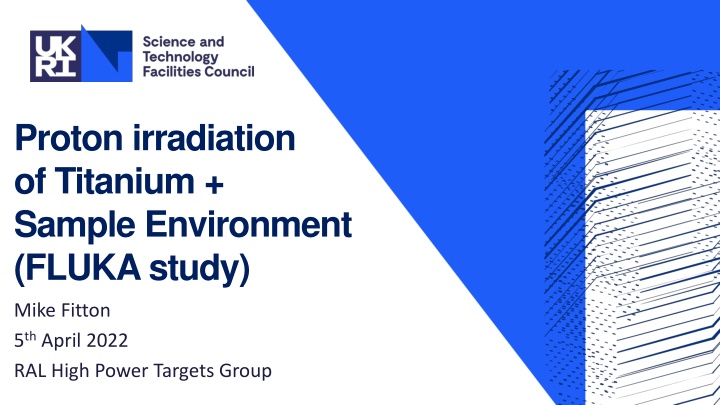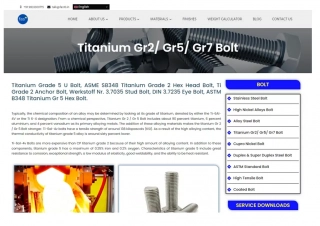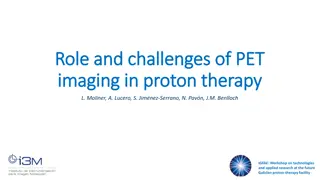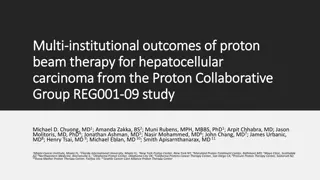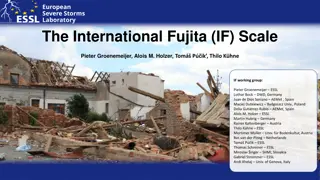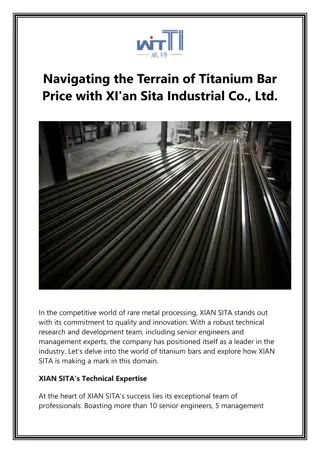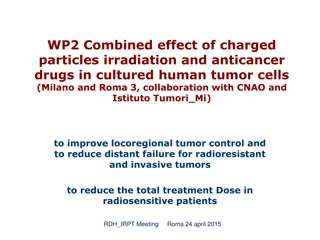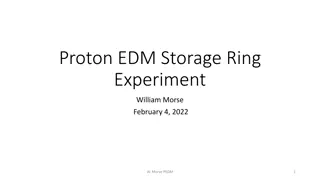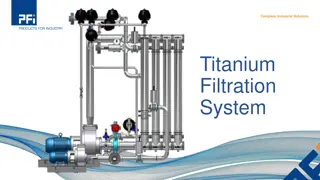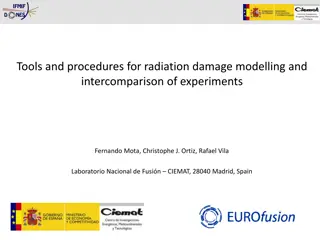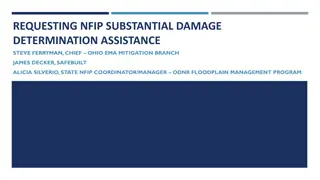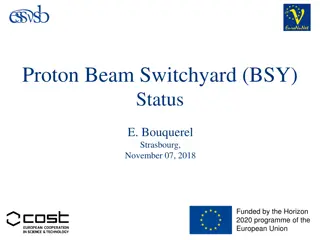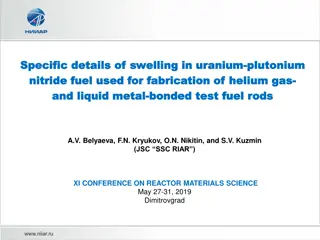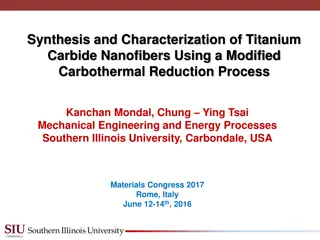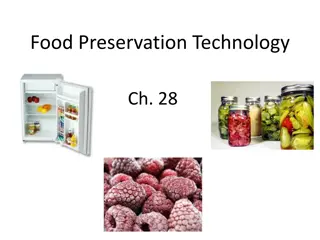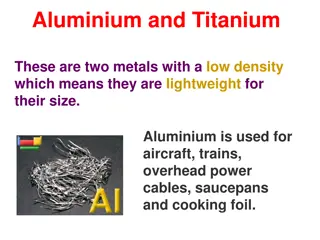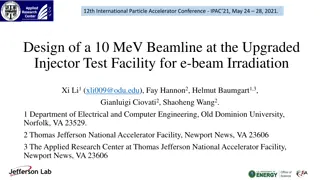Proton Irradiation of Titanium - Damage Studies and Sample Environment
This study discusses proton irradiation of titanium, focusing on damage studies and sample environment at the Birmingham cyclotron. It covers the design, energy thresholds, hydrogen and helium production, sample environment outline, beam characteristics, and shielding. The optimal energy range, damage threshold, and implications for medical isotope production are explored.
Download Presentation

Please find below an Image/Link to download the presentation.
The content on the website is provided AS IS for your information and personal use only. It may not be sold, licensed, or shared on other websites without obtaining consent from the author.If you encounter any issues during the download, it is possible that the publisher has removed the file from their server.
You are allowed to download the files provided on this website for personal or commercial use, subject to the condition that they are used lawfully. All files are the property of their respective owners.
The content on the website is provided AS IS for your information and personal use only. It may not be sold, licensed, or shared on other websites without obtaining consent from the author.
E N D
Presentation Transcript
Proton irradiation of Titanium + Sample Environment (FLUKA study) Mike Fitton 5th April 2022 RAL High Power Targets Group
Titanium damage studies Irradiation at Birmingham cyclotron Sample environment design Birmingham cyclotron can deliver protons at energies in 15-40MeV range. T2K -> 30GeV LBNF -> 120GeV Ti Damage threshold used = 30eV Optimum performance is around 28- 30MeV where the beam current is 30uA Most beam time will be available at 28MeV as the same as medical isotope production (a regular commitment for MC40) With 30 days irradiation ~1DPA in the titanium is achieved. Damage is higher at Bragg peak but gas production is unrealistic (next slide) At 30MeV the range in titanium is approximately 3mm T2K and LBNF
Titanium damage studies Irradiation at Birmingham cyclotron H / He production Hydrogen production is slightly lower (~1/5th) at 10 s MeV compared to T2K (30GeV) except at the Bragg peak where it is much higher (x45+!) Avoid the Bragg peak as H production is unrealistic. This could cause swelling, cracking, etc 30 GeV Helium production is much lower (~1/30th) with lower energy irradiation Could implant He-ions but range is very limited 30 MeV Helium production Hydrogen production 30 GeV (T2K) 130 MeV (BLIP) 30 MeV (MC40 at B ham)
Titanium damage studies Irradiation at Birmingham cyclotron Sample environment outline design Example of FLUKA model Stainless steel enclosure Graphite beam dump 30MeV proton beam 0.564cm radius 6082 Aluminium window Titanium foils ~9-10 x 0.25mm Nitrogen gas Example energy deposition used for engineering design
28MeV is preferable to 30MeV as used for medical isotope production More beamtime ! Aluminium or Beryllium window? -> For cost and simplifying H&S Aluminium is preferred Downside to these minor changes is that we loose foil 10 and put Bragg peak in foil 9 Graphite beam dump At 28MeV and with aluminium window Bragg peak in foils 9+10 -> 10 x 0.2mm foils?? Window Be window allows more beam to samples Foil 10 Foil 9 Foil 5 Foil 1
Shielding enclosure and dose rate (after 30 days continuous running) 30uA proton beam 1cm2 cylindrical beam 30 days running 20mSv/hr mSv/hr 0.1mSv/hr mSv/hr 1mSv/hr
Activation of samples and samples environment hardware Samples are grade 5, but include the maximum allowable 0.25% Fe Table shows results after 30 days continuous running at 30mA, 1cm2 cylindrical beam Residule nuc [GBq] Foil 1 (Ti-6Al-4V) Foil 2 (Ti-6Al-4V) Foil 9 (Ti-6Al-4V) Foil 10 (Ti-6Al-4V) 6082 Al window IG-11 dump 1 hour 1 day 1 week 1 month 6 months 38.38 35.70 34.31 0.02 0.27 0.00 19.71 18.99 32.53 0.01 0.22 0.00 10.66 11.29 25.25 0.01 0.18 0.00 3.68 4.07 9.54 0.00 0.13 0.00 0.38 0.40 0.22 0.00 0.06 0.00 316 SS enclosure 2.29 0.98 0.75 0.57 0.17 Total inventory around 300+GBq (Higher than the 100GBq facility limit) Irradiating samples only at night (e.g. 6hrs per day) should keep inventory near to limit No significant difference in the activation between grade 2 and grade 5 Vanadium-48 responsible for most short term activation Vanadium-49 & Scandium-46 responsible for long lived activation
After long cooling period the upstream foils are hottest Initially the downstream foils are the hottest Reason is more long lives isotopes (e.g Sc-46) produced where energy is highest
Activation of Nitrogen cooling gas Table below shows the activation of the Nitrogen gas in the gap between the window and first sample. 30days running 1minute and 1 day cool Window gap (30days irradiation) 1 min decay A Z 13 11 14 10 7 15 14 Total Window gap (30days irradiation) 1 day decay A Z Bq 7 4 1.94E+04 14 6 11 6 6.72E-16 13 7 8.41E-38 Total 1.94E+04 Bq error Isotope Half life 9.96 min 20.39 min 70 sec 19 sec 53.1 days 122.2 sec 5730 years error Isotope Half life 53.1 days 5730 years 20.39 min 9.96 min 7 2.48E+06 6 1.18E+06 8 3.35E+05 6 7.13E+04 4 1.97E+04 8 6 0.1396 4.10E+06 4.193 N-13 7.279 C-11 7.651 O-14 9.717 C-10 25.57 Be-7 56.24 O-15 56.24 C-14 25.57 Be-7 56.24 C-14 7.279 C-11 4.193 N-13 0.1396 9993 Main isotope production is Nitrogen-13 and Carbon-11. Both have a short half life Although small amounts, Beryllium-7 is the only significant isotope with longer half-life If Helium was used as cooling gas the activation would be lower. Actual environmental conditions of windows and targets Inside Outside T2K Dry pure Helium / Vacuum Low purity Helium + H2O LBNF Dry pure Helium Nitrogen + H2O
